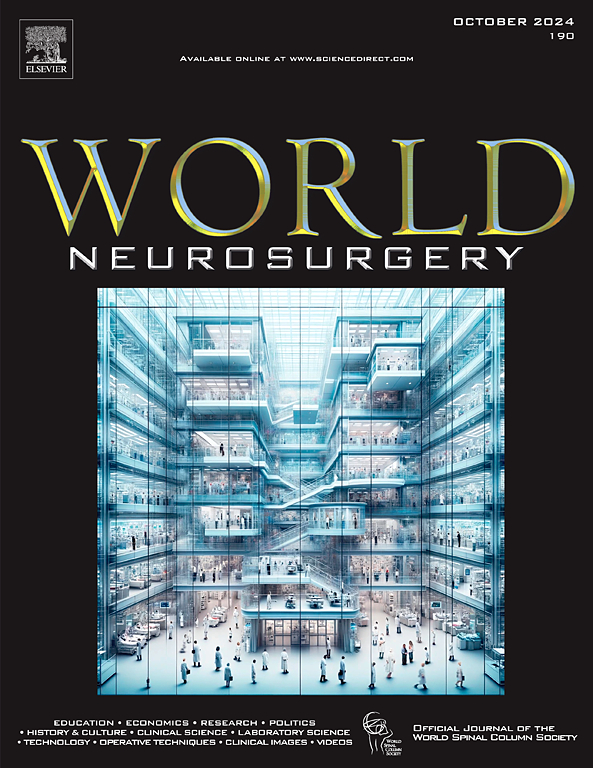Incidence and Risk Factors of Delayed Facial Paralysis After Vestibular Schwannoma Resection: A Systematic Review and Meta-Analysis
IF 1.9
4区 医学
Q3 CLINICAL NEUROLOGY
引用次数: 0
Abstract
Objective
Delayed facial nerve paralysis (DFNP) is a common complication after vestibular schwannoma surgery. Previous studies have focused on immediate facial nerve paralysis, and the risk factors for developing DFNP remain largely unclear. This study aimed to determine the incidence and risk factors of DFNP in patients after vestibular schwannoma resection.
Methods
Up to 8 October 2024, PubMed, Embase, Cochrane Library, Web of Science, China National Knowledge Infrastructure, Wanfang Data, and China Science and Technology Journal Database were searched to extract the related data of DFNP. The pooled incidence of DFNP was calculated. Possible risk factors of DFNP were conducted to report the odds ratio/weighted mean difference (WMD), and their 95% confidence intervals (CIs).
Results
Twenty-seven studies were included, and 8656 patients underwent vestibular schwannoma resection. The incidence of DFNP in patients with vestibular schwannoma who underwent microsurgical resection was 12.3% (95% CI: 9.4%, 15.1%). The results of the influencing factor analysis showed that age (WMD: −4.28, 95% CI: −5.66, −2.91) and tumor size (WMD: 0.17, 95% CI: 0.01, 0.22) were related to the incidence of DFNP in patients after vestibular schwannoma resection.
Conclusions
DFNP is a complication after vestibular schwannoma surgery that cannot be ignored. The risk factors (age and tumor size) of DFNP in patients after vestibular schwannoma surgery still need to be considered, and clinical management of high-risk groups should be strengthened in clinical practice.
前庭神经鞘瘤切除术后迟发性面瘫的发生率和危险因素:一项系统回顾和荟萃分析。
目的:延迟性面神经麻痹是前庭神经鞘瘤术后常见的并发症。以前的研究主要集中在立即发生的FNP,而发生DFNP的危险因素在很大程度上仍然不清楚。本研究旨在确定前庭神经鞘瘤切除术后患者DFNP的发生率及危险因素。材料与方法:检索到2024年10月8日,检索PubMed、Embase、Cochrane Library、Web of Science、中国知网(CNKI)、万方数据、中国科技期刊数据库(VIP),提取DFNP相关数据。计算DFNP的合并发生率。对DFNP可能的危险因素进行分析,报告优势比(OR)/加权平均差(WMD)及其95%置信区间(ci)。结果:纳入27项研究,8,656例患者行前庭神经鞘瘤切除术。行显微手术切除的前庭神经鞘瘤患者DFNP的发生率为12.3% (95%CI: 9.4%, 15.1%)。影响因素分析结果显示,年龄(WMD: -4.28, 95%CI: -5.66, -2.91)和肿瘤大小(WMD: 0.17, 95%CI: 0.01, 0.22)与前庭神经鞘瘤切除术后患者DFNP发生率相关。结论:DFNP是前庭神经鞘瘤术后不可忽视的并发症。前庭神经鞘瘤术后患者发生DFNP的危险因素(年龄、肿瘤大小)仍需考虑,临床实践中应加强对高危人群的临床管理。
本文章由计算机程序翻译,如有差异,请以英文原文为准。
求助全文
约1分钟内获得全文
求助全文
来源期刊

World neurosurgery
CLINICAL NEUROLOGY-SURGERY
CiteScore
3.90
自引率
15.00%
发文量
1765
审稿时长
47 days
期刊介绍:
World Neurosurgery has an open access mirror journal World Neurosurgery: X, sharing the same aims and scope, editorial team, submission system and rigorous peer review.
The journal''s mission is to:
-To provide a first-class international forum and a 2-way conduit for dialogue that is relevant to neurosurgeons and providers who care for neurosurgery patients. The categories of the exchanged information include clinical and basic science, as well as global information that provide social, political, educational, economic, cultural or societal insights and knowledge that are of significance and relevance to worldwide neurosurgery patient care.
-To act as a primary intellectual catalyst for the stimulation of creativity, the creation of new knowledge, and the enhancement of quality neurosurgical care worldwide.
-To provide a forum for communication that enriches the lives of all neurosurgeons and their colleagues; and, in so doing, enriches the lives of their patients.
Topics to be addressed in World Neurosurgery include: EDUCATION, ECONOMICS, RESEARCH, POLITICS, HISTORY, CULTURE, CLINICAL SCIENCE, LABORATORY SCIENCE, TECHNOLOGY, OPERATIVE TECHNIQUES, CLINICAL IMAGES, VIDEOS
 求助内容:
求助内容: 应助结果提醒方式:
应助结果提醒方式:


